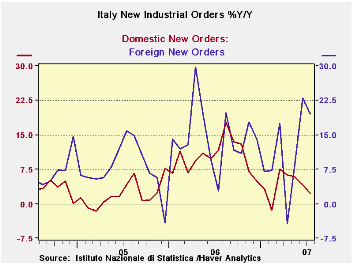 Global| Sep 19 2007
Global| Sep 19 2007Italy’s Orders Show Volatility as Domestic Orders Slow
Summary
Euro-zone orders have begun to get choppy with weakness seen in foreign German orders in July and now a M/M drop in Italys foreign orders. AND while some of the MFG surveys are off peak, most industrial readings still stand at good [...]

Euro-zone orders have begun to get choppy with weakness seen in foreign German orders in July and now a M/M drop in Italy’s foreign orders. AND while some of the MFG surveys are off peak, most industrial readings still stand at good solid levels. This month, despite some volatility the same is true for Italy.
Still, Italy’s foreign orders are strong, since orders had risen by more in June. The annualized three-month growth rate is 52.7%. Domestic orders that were up by a strong-seeming 1.3% in July are the ones that are slowing over three months with an annualized growth rate of 5.4%. That is still not a weak figure. Overall sales are up at a 14% pace in the three months ending in July.
In the third quarter, these figures imply growth of 26.9% in foreign orders and of 6.2% in domestic orders. Sales in Q3 are up at a 7.7% pace. So far this is a good start. But orders can be volatile. There have been other signs in the Euro area that have pointed to slowing, including MFG survey and orders and industrial production reports of other EU nations. Italy’s industrial figures at this point, while showing volatility, are not showing weakness.
| SAAR ex M/M | Jul-07 | Jun-07 | May-07 | 3-mo SAAR | 6-mo SAAR | 12-mo |
| Total | -0.4% | 2.5% | 2.5% | 20.3% | 19.5% | 7.9% |
| Foreign | -3.4% | 9.2% | 5.4% | 52.7% | 34.3% | 19.6% |
| Domestic | 1.3% | -1.0% | 1.0.% | 5.4% | 11.8% | 2.2% |
| Memo: | ||||||
| Sales | 1.2% | -1.9% | 4.1% | 14.0% | 8.0% | 8.3% |
| 7COLSPAN |
Robert Brusca
AuthorMore in Author Profile »Robert A. Brusca is Chief Economist of Fact and Opinion Economics, a consulting firm he founded in Manhattan. He has been an economist on Wall Street for over 25 years. He has visited central banking and large institutional clients in over 30 countries in his career as an economist. Mr. Brusca was a Divisional Research Chief at the Federal Reserve Bank of NY (Chief of the International Financial markets Division), a Fed Watcher at Irving Trust and Chief Economist at Nikko Securities International. He is widely quoted and appears in various media. Mr. Brusca holds an MA and Ph.D. in economics from Michigan State University and a BA in Economics from the University of Michigan. His research pursues his strong interests in non aligned policy economics as well as international economics. FAO Economics’ research targets investors to assist them in making better investment decisions in stocks, bonds and in a variety of international assets. The company does not manage money and has no conflicts in giving economic advice.






